Playing guitar along to a drummer or a beat of some kind is probably one of the more important skills that many guitar players overlook.
There are five essential things to do when playing guitar with drums, and we’ll explore them in detail below.
1) Pay attention to each part of the kit to figure out what part is keeping time.
2) Use the Snare/Kick/Cymbal as a frame of reference for your playing
3) Accent your playing to the point at which the beat hits.
4) Pay attention to the space between the beats
5) Play with the Groove
Most guitar players are busy practicing songs they like, scales, and specific parts of their technique, rather than focusing on their rhythm and ability to actually play along with others and be able to keep time.
It’s also one of the skills that separate an experienced player from a less experienced player.
If you’ve been playing guitar in your room for your entire life, and one day decide that you’re going to jam with others, you might find that you’ve developed all kinds of bad habits over the years that you have to either mitigate or unlearn entirely. Some of these will be harder to unlearn than others and some will have to be forgotten (my guide on how long it takes to forget how to play).
The reason why playing along with either a click, metronome, or more importantly, a drummer, is so important is because it teaches you how to keep time. It’ll also help you record along to a backing track (my guide on this) or record a song.
If you can’t keep time as a player, you’ll struggle to play with others, and you might even find that you have trouble recording songs properly because you can’t play at the same tempo consistently as well as you thought.
Regardless, if you’re reading this article, that means you’re ready to start working on this essential skill that separates you from the plethora of guitarists who don’t know how to keep time and therefore play with others.
In this tutorial, I’m going to offer a series of tips for playing guitar along with a drummer as well as how to prepare for one.
How To Play Guitar With Drums
1) Pay attention to each part of the kit to figure out what part is keeping time
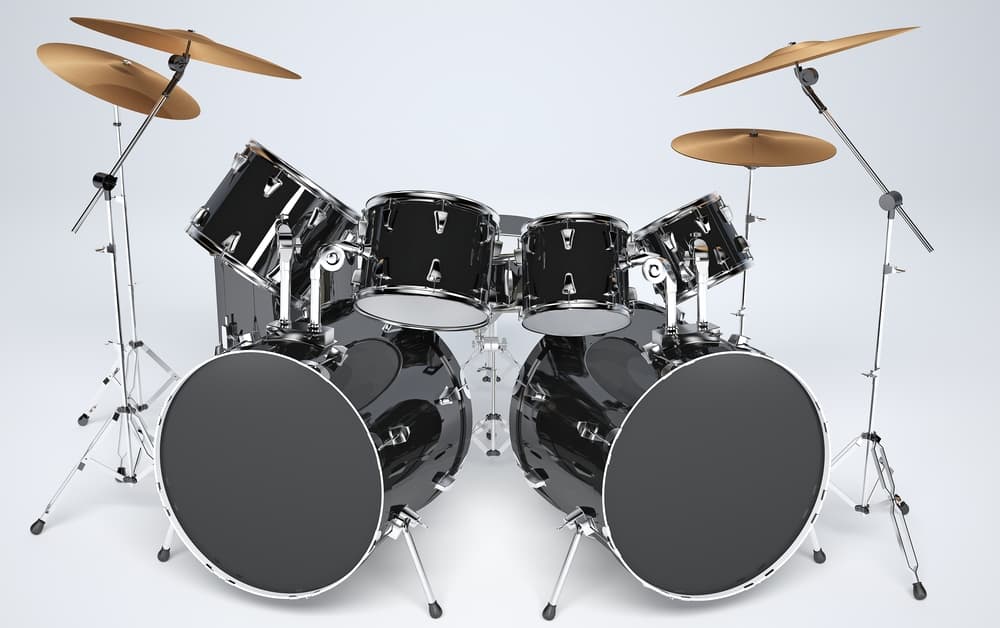
First things first, you want to pay attention to the individual parts of the kit and understand what part of the kit is keeping time the most consistent.
There are certain parts of the kit that are holding up the foundation and timing of the song more than others.
They are usually the Kick and the Snare, but they don’t have to be one of these. In other words, a good drummer is usually using at least one part of the kit to keep time all of the time, whereas the other parts of it may be for fills or added rhythm.
For instance, I would argue that the snare is the most commonly used part of the kit for keeping time. This is especially the case for hip-hop, but from what I can tell, it’s also pretty important for metal.
Additionally, it’s not uncommon for a cymbal, a ride, or a crash to keep time in metal as well.
Pay attention to the point at which the snare is being hit. This is giving you an idea of where the beats are.
An example that jumps out in my mind is the solo for “Reptile” from Periphery’s new album.
Whenever I listen to Misha Mansoor’s solo at the end of the song, I’m listening to the way Matt Halpern is playing the snare, and how Misha’s solo is played in conjunction with that snare beat.
2) Play the guitar while using the Snare/Kick/Cymbal as a frame of reference.
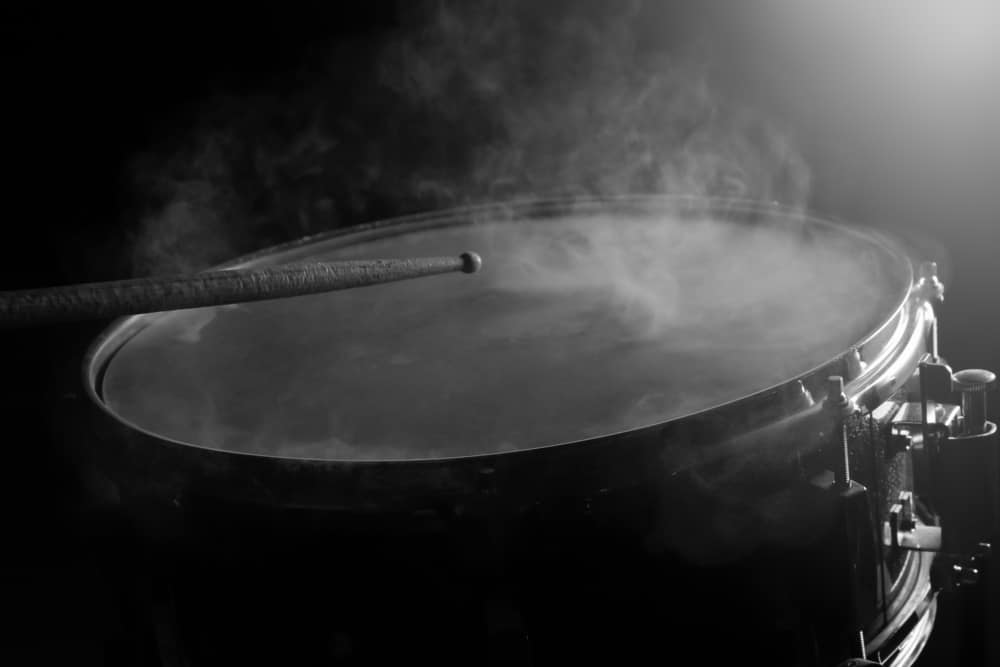
It’s best to play your instrument along “with” the drummer, rather than “to” the drummer.
What that means is that you’re using the beats as a frame of reference for your playing, and using it to help keep time and the tempo consistent. As I just mentioned, there are a number of ways that a drummer keeps time; it doesn’t always have to be the kick or the snare.
Sometimes it can be with the hi-hats, the cymbals, the kick, or the snare. Regardless, and as I said, there is usually at least one part of the kit that’s keeping time, and you should always have this in mind.
On the other hand, don’t be a slave to it. Just keep it in mind, and think of the music as a whole, rather than as individual parts.
Once you practice this enough, you won’t even have to think of it, you’ll be able to bob your head along with the drumming rhythm without much effort.
3) Accent your playing at points where the beat hits
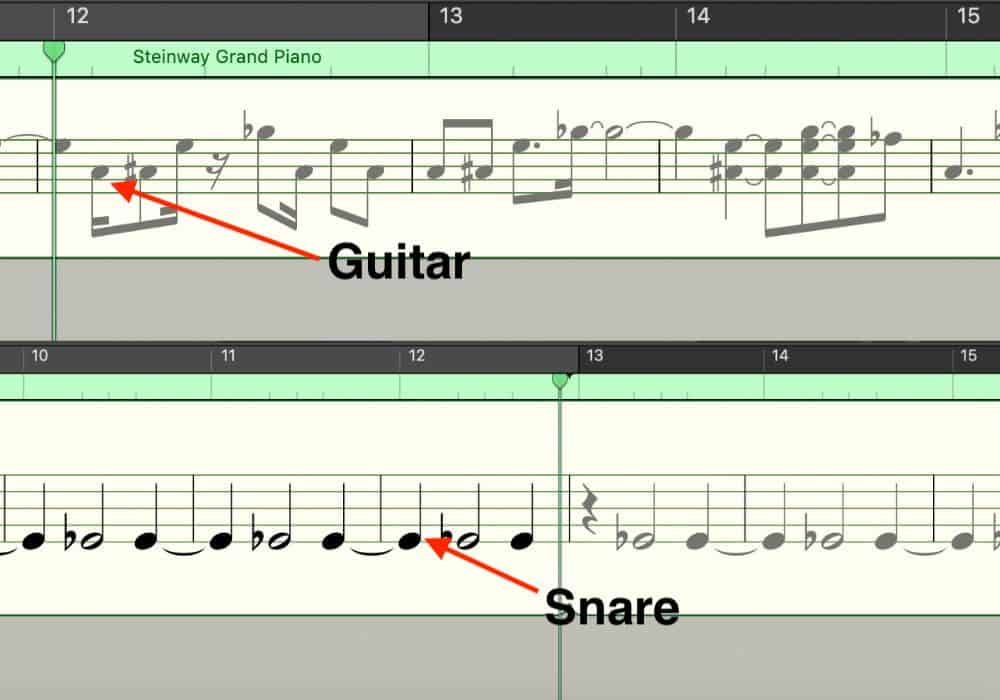
In other words, what you want to do is play your riff or whatever song you’re playing as usual, but accent the part of your phrase at the same time as each beat, whether it’s with a downstroke or an upstroke.
By accenting particular notes along with the beat, the way I look at it, it’s kind of like you’re gluing everything together. It’s a form of synchronization with the drummer. The Red Hot Chili Peppers are notorious for having a synchronized sound.
You don’t always have to do this, but it’s going to give you a better idea of where the beats are.
An accent doesn’t necessarily have to be hitting the note harder on the beat either. You could just hit the note slightly harder on the beat.
You could play it softer or quietly, or maybe you could quickly do a hammer-on or pull-off, just do something to remind yourself of where the beats are.
It could also be the beginning of a particular part of your phrase, for instance, it could be the beginning of an arpeggio or a pinched harmonic. It could also be a bend.
One thing that I like to do when I’m playing along to hip-hop songs, is that I pay attention to the snare, and I end a fast run on the snare beat, finishing it off with a bend that falls exactly on that beat. This is the quality that actually makes it sound like music.
4) Pay attention to the space between the beats

You don’t always have to play notes exactly on the beat. The purpose of the drummer, in relation to the guitarist, is not to obsess over it, but use the drummer as a guiding light for your playing.
Think of the spaces between each beat, and keep your playing synchronized with the beats and the spaces between each beat.
There are a number of ways to practice this, including actually counting the beats as they come. If you’re playing along with a drummer, it might actually help to count the beats in your head, assuming you know your part enough so you don’t have to think about your playing.
5) Play with the Groove
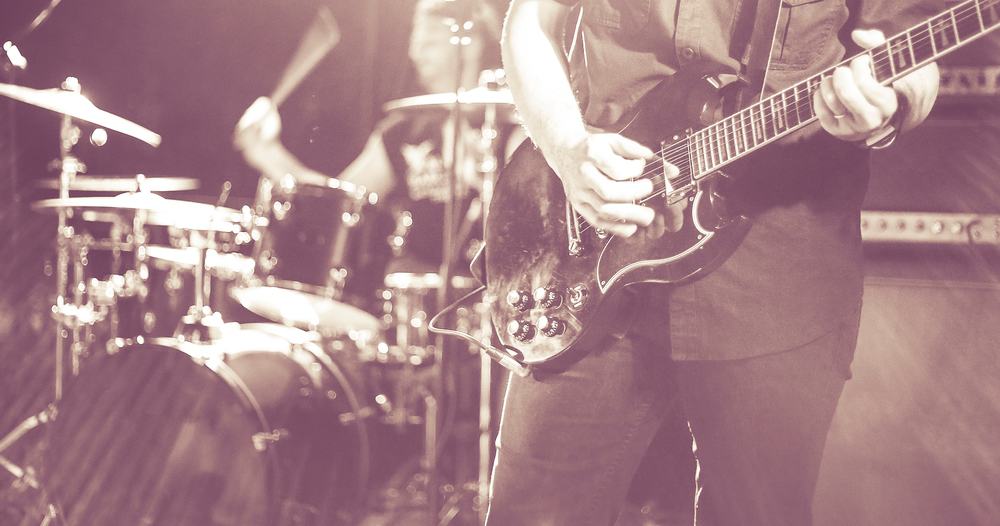
Listen to the drums and rhythm section of the song and get a feel for the groove.
There’s really no way of explaining this without sounding pretentious, but every song has a particular groove to it, and understanding how to be in sync with it is essential.
Understand the main beat and rhythm of the track using the tips I laid out for you above, and playing along with it, rather than to it.
Whenever you play along with a drummer, don’t be in fear of drifting away from the beat. Some people find themselves either getting in front of or behind it.
Most guitar players make the mistake of wanting the drummer to get behind them, or in other words, adjust to their playing style. You don’t want to be doing this.
Expecting the rest of the band to revolve around the guitar is likely a consequence of the importance or significance of the guitar in our culture rather than the drums.
6) Practice constantly
This isn’t something that’s learned overnight. You want to be playing with a drummer all of the time and getting a feel for how to be going about doing this.
Over time, you won’t even have to think about the beats or the rhythm, and you’ll just hear the drummer and be able to play along with them without counting along to it.
Thankfully, there are a number of ways you can practice playing along with a drummer without actually having one present.
How To Prepare For Playing With A Drummer
Computer technology has come a very long way, and nowadays, even if you do play at home in your room, there are things that you can do to help your technique in this area.
I touched on this on my tutorial for learning how to play with a click-track, which I recommend you check out here.
Regardless, I would say arguably the four best things that you can do to practice playing with a drummer is the following:
1) Play with Garageband’s Drummer Track
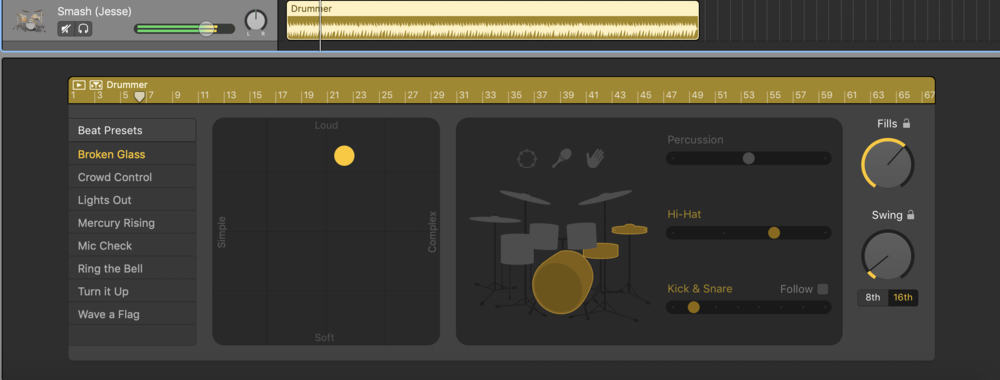
Garageband’s Drummer Track is arguably one of the greatest songwriting and practicing tools available right now.
The drummer track comes with a plethora of options, including the ability to create your own drums; the ability to change the style; the ability to change the tempo, and at more than one part of the music; as well as adjust each part of the kit.
If you want to know how the drummer track works in Garageband, I recommend checking out the article from Garageband Professional, Tips And Tricks For Using The Drummer Track In Garageband. The article runs through each part of the software and how to go about using it.
The great thing about Garageband’s Drummer Track is that you can change the tempo wherever you want, adjust how much syncopation there is, and throw in little phrases and fills, that way you’re used to the drummer always changing.
Truthfully, nothing will replace playing with an actual drummer, but using the Drummer Track is going to give you a nice solid foundation to practice with, that way you’re not totally clueless when it comes time to play with one.
2) Always Play With A Click-Track or Metronome
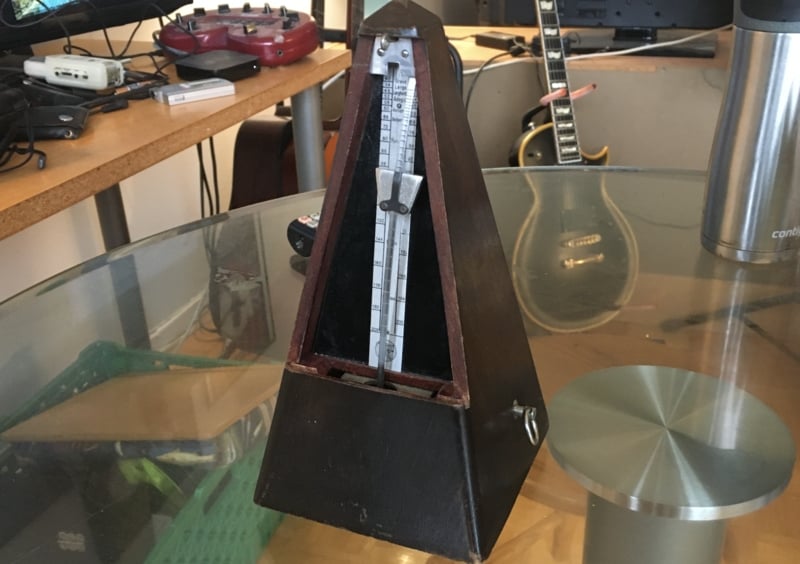
While it’s great to noodle around on the guitar aimlessly, and I do this all of the time, you always want to have at least some type of frame of reference for your playing.
If you find yourself practicing scales, arpeggios, and so on and so forth, make sure that you’re either using a click-track or metronome, that way you’re always practicing your ability to keep time.
It’s important to note that there are drawbacks to always playing with a metronome, so keep that in mind. For instance, a metronome or a click-track is very consistent, and it’s not a real-life human, whose playing is dynamic and likely always changing.
Additionally, using a metronome can get quite boring.
3) Play Along To Music and Recordings
As I wrote in the article that I linked above about playing with the click-track, one of my favourite things to do is play along to popular hip-hop songs.
The reason for this is that hip-hop songs, especially in the mainstream, typically don’t have time signatures or tempo changes. The song’s sense of rhythm is typically constant.
For this, you’re going to have to figure out how to figure out a song’s key signature, and how to improvise with the song.
In other words, the added benefit of improvising with random songs that you find on Spotify or other platforms is that you’re practicing not only your sense of rhythm and timing but also your improvisation skills and your ability to play theoretical knowledge.
Playing along to your favorite songs is another way to learn this as well as JamPlay.
4) Pay attention to the drums in conjunction with the guitar playing in your favourite songs
While this seems like a throwaway tip, it really isn’t. Whenever you’re listening to music, try to avoid just listening to the way that the guitar or vocals sound.
Analyze the music and pay close attention to the way the bass, guitar, and drums are playing together, and try to understand at which point the guitar player is plucking their notes to the snare, kick, ride, or crash.
This doesn’t mean that you should pull out a pen and paper and literally analyze it. It’s more like just keeping it in mind, and closely listening to the music cohesively, rather than focusing on the parts that stand out in your mind as well.
This tactic is useful for not only improving your own sense of playing but also for bettering your mixing skills. In other words, you can pay attention to the way the instruments, vocals, bass, guitar, and drums are placed in the mix. I do this all of the time.

 Written By :
Written By :